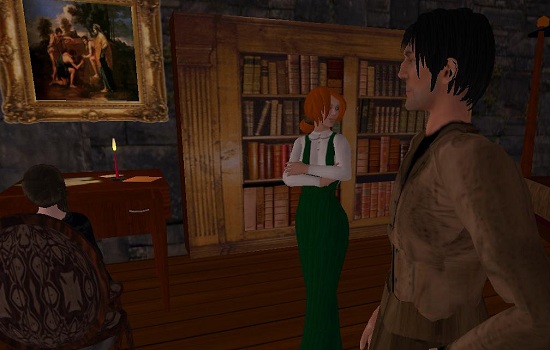[Editor: Joe Essid teaches a class about Edgar Allen Poe’s “Fall of the House of Usher” for the department of English & Rhetoric & Communication Studies at the University of Richmond, using virtual space on the JokaydiaGrid.]
With some glitches along the way, six groups of students completed their final exams, or at least the immersive experience upon which they’ll base a take-home essay exam.
It all began very poorly, and that’s a warning to those working in OpenSim for classroom work critical to students’ grades. The first day, the grid would not load, but I was in luck: the one student in the lab happily delayed his journey to the House of Usher and joined a group later in the week. Jokay Wollongong [Jo Kay], our grid manager, was thenceforth online for every exam: thank God. We had a serious crash later in the week, but Jokay restarted the region and we all relogged. In fact, we roleplayed the disorientation within the scope of Poe’s story, and odd things do happen to Poe’s characters.

The culprit for our crash may be the old server software that runs Jokaydia Grid. Jokay cannot fix that, but the owners of the servers at ReactionGrid can. The good news is that ReactionGrid plans an upgrade next week. I’ll hold them to this — I want to restore hypergrid availability to our build.
A word about the talented folks at ReactionGrid: the company has switched emphasis in recent months to Jibe virtual world technology. Jibe is promising for ease of use and the ability to run inside any Web browser. On the other hand, it’s not for those who wish to build collaboratively in-world and in real time with students. That’s a killer app for my use of virtual worlds. Jibe’s protocols for 3D object design, like those of SL’s recently introduced Mesh technology, are beyond my and my students’ skills; Richmond lacks enough advanced arts students who might wield Maya or Blender. And there is no incentive for faculty here to learn.
On the other other hand, prim-work in OpenSim or Second Life are within my skills set and those of the student-builders I train, often in teams working together, so that’s where I’ll stay.
As for getting hypergridding back? It offers special affordances for educators. That, after all, is how edutech works: we share and link to each other. Even Blackboard, the course-management behemoth, is now moving to a more open model with the arrival of a “share” button.
The closed-grid model, on any platform, is that of the video-game world. It protects IP and functions for gamers and socializers, but it’s not best for many of my colleagues in education. I give my own content away with Creative-Commons licensing or in the Public Domain. We are even considering whether we have tech support, locally, to host an OpenSim grid on our campus, as schools such as the University of Bristol are doing as they pull their work out of Second Life.
As we move forward to new engagements in an OpenSim grid or Second Life, I still need more data. From my students’ essays, I plan to gather data for an article about effective educational roleplay and types of student roles. But I’ve already learned one lesson: without Jokay Wollongong’s hands-on help, I’d never have trusted Reaction Grid’s old version of OpenSim for something as crucial as a final exam.
Next up, I’ll finish the Usher series from Jokaydia Grid with reflections by the students, from their exam essays. And a surprise twist right out of Poe: Usher is coming back to Second Life!
- 5 lessons from 6 years of virtual world teaching - May 1, 2013
- The Sweet Smell of Desperation - March 15, 2013
- An educator looks at Cloud Party - June 21, 2012
